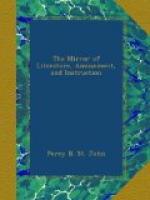matter appears to be occasionally absorbed by the
root. This colouring substance is, however, never
a deep green. Red and yellow, as may be seen
in forced rhubarb, &c., are the most common hues.
Succulent plants are less susceptible of the influence
of light than any others. As they are always
natives of hot countries, nature, to prevent the danger
they would be exposed to from excessive evaporation,
has provided them with leaves almost destitute of
pores; and the moisture they absorb by their roots
thus remains for the nourishment of the plant.
It is for this reason that cactuses, mesembryanthemums,
and other plants of a similar description, require
very little water when kept in pots. Scarcely
any carbon is found in plants grown in the dark.
Many experiments have been tried to show the stimulus
afforded to vegetation by light; trees of the same
species and variety have been planted in the same
garden and the same soil, but against walls with different
aspects, and differently situated with regard to shade.
The effect has been, not only a difference in the growth
and appearance of the tree, but also in the size,
colour, and flavour of the fruit which it produced.
The contrast between plants grown in hot-houses with
wooden sash frames, and those grown in hot-houses with
iron sash-frames, has been found equally striking;
the difference of light between the two kinds of houses
being as seven to twenty-seven, or, sometimes, as
three to twenty-three. Light is required at an
early period of vegetation; but, as its properties
are to give strength and flavour, it must be admitted
with caution, as it is sometimes injurious. Too
much light renders the skin of fruits tough, and will
make cucumbers bitter. Berard of Montpelier found
that the ripening of fruits is merely the turning
the acid which they contain into sugar, by exposure
to the light; and that too much light and heat, before
they have attained their proper size, will bring on
premature ripening, and make them insipid.
Lindley’s Lectures, reported in the Gardeners’
Magazine.
* * * *
*
PLANTS IN ROOMS.
It is very difficult to make plants grow in rooms.
They must necessarily be deficient in the three important
auxiliaries to vegetable life, light, air, and moisture;
the latter of which cannot be maintained in apartments
that are daily occupied. In large towns, plants
cannot thrive even in the open air, as the minute particles
of soot, which are constantly floating about, settle
upon their leaves, and choke up their pores.
The gases produced by the combustion of coal, &c.,
are also injurious to plants. Sulphurous acid,
which abounds in the atmosphere of London, turns the
leaves yellow; and the want of evaporation and absorption
by the leaves prevents the proper elaboration of the
sap, and makes the trees stunted and unproductive.
Ibid.




